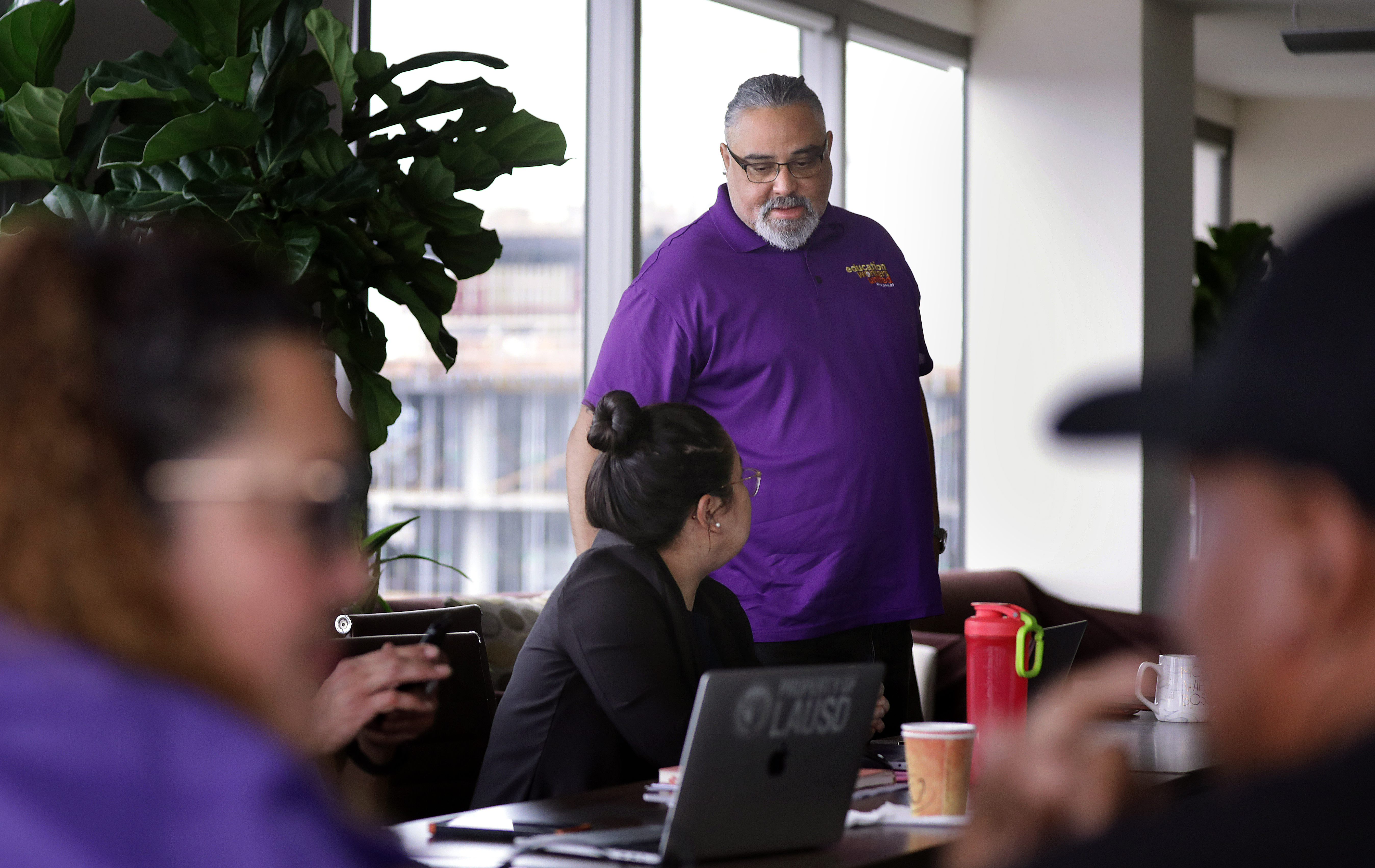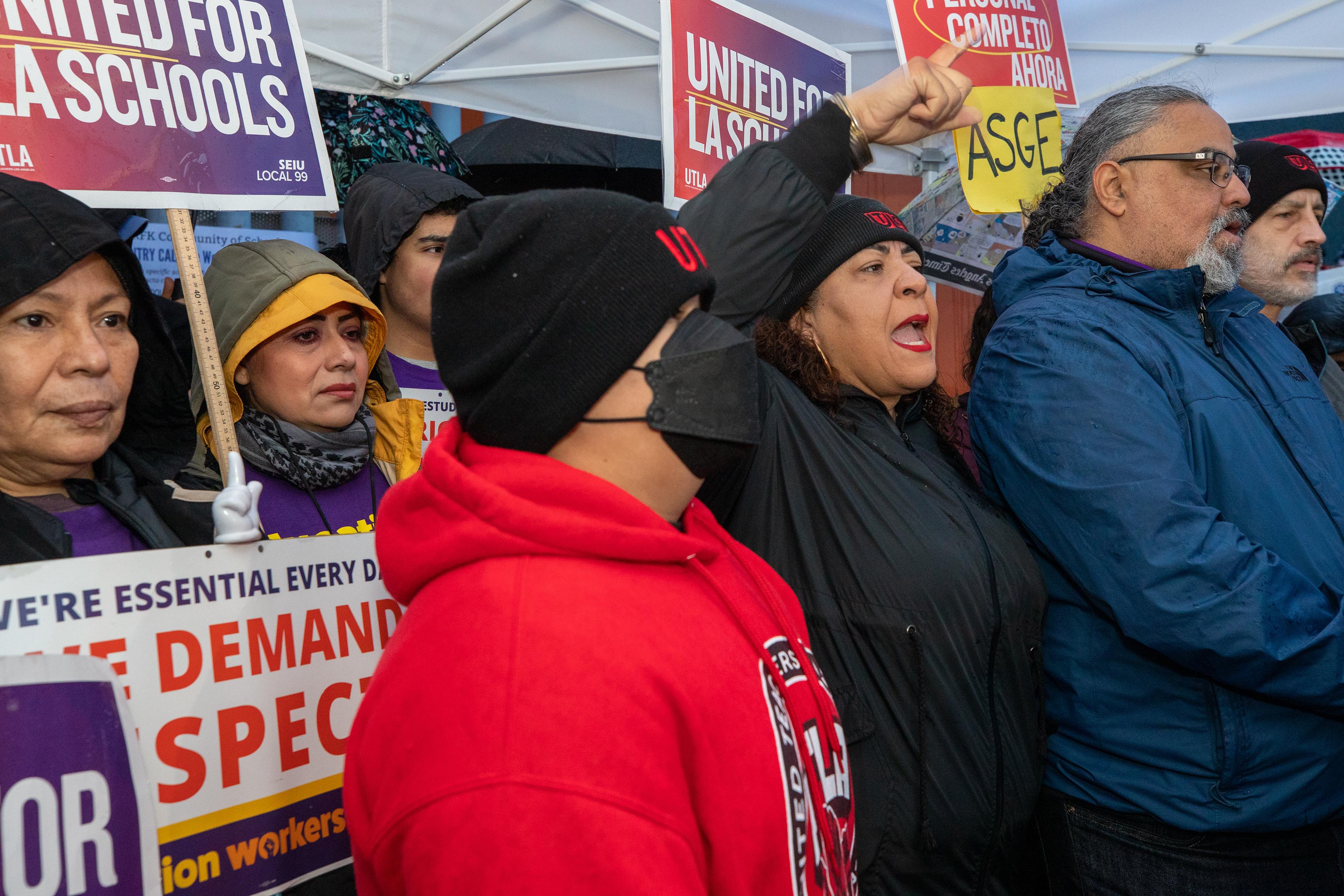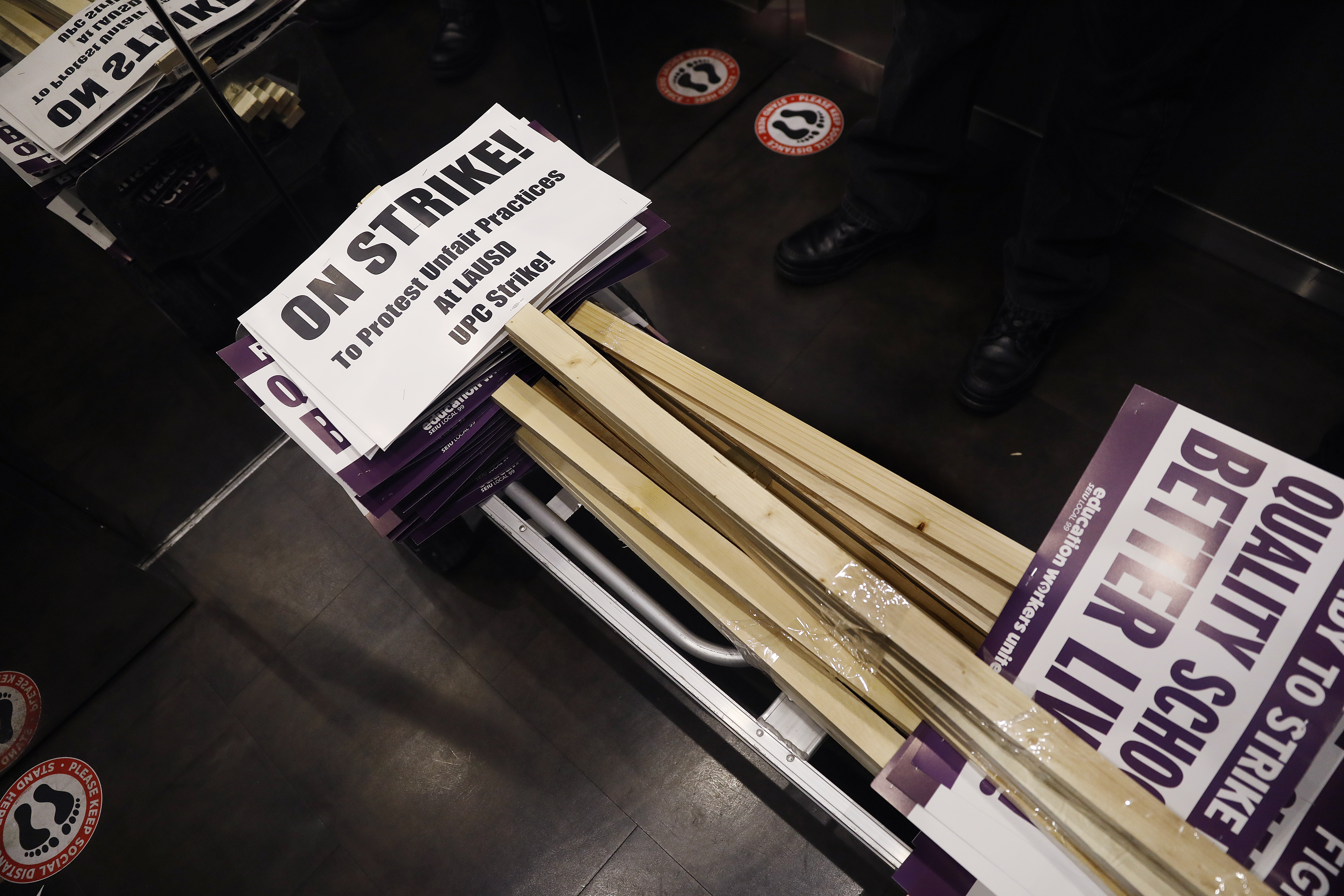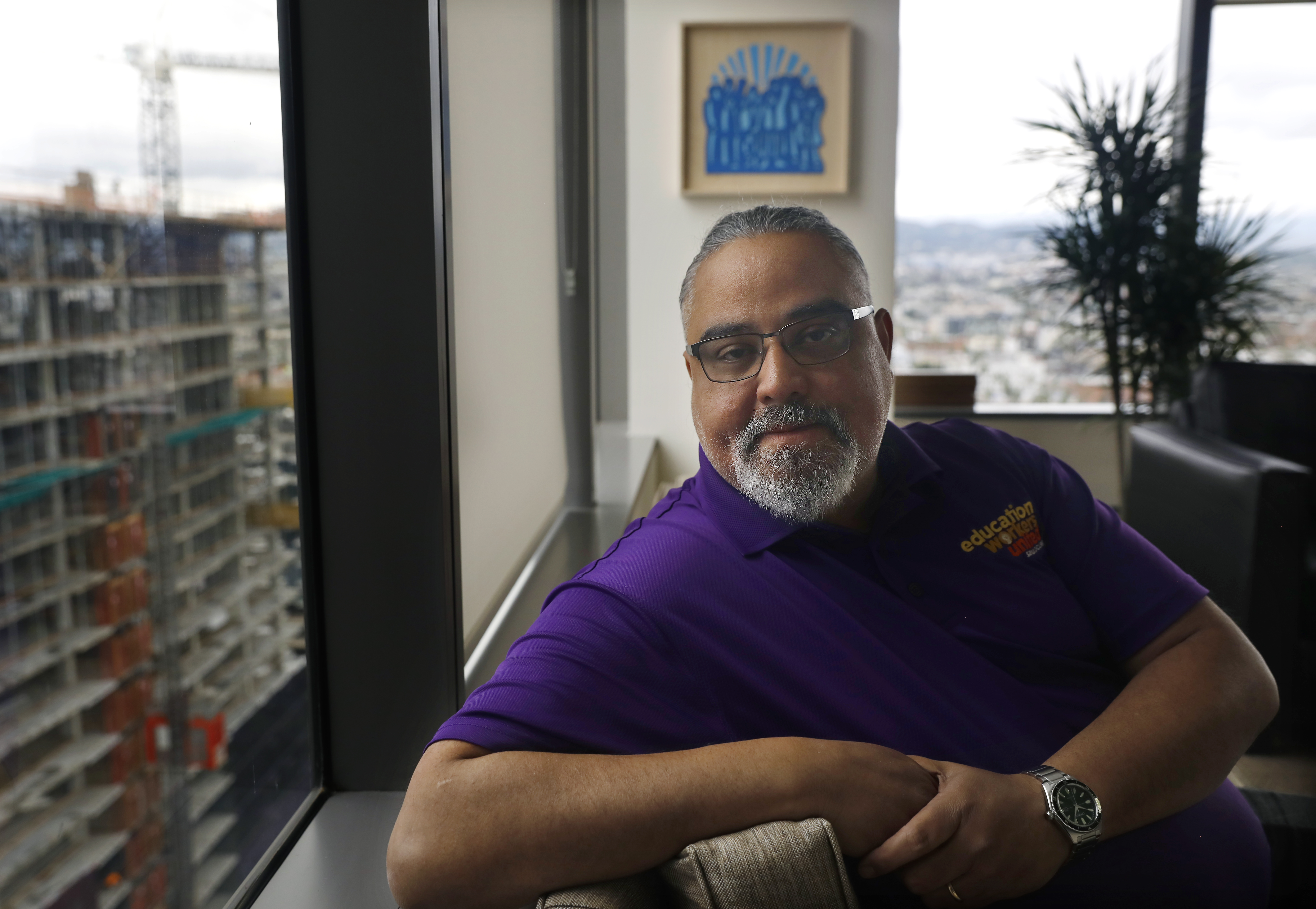He helped LAUSD’s most “invisible” workers go on strike, but Max Arias isn’t done yet
Education, LA Politics
Gustavus ArellanoMarch 22, 2023
The latest storm in Southern California did not dampen the spirits of more than 300 workers who gathered in front of a school bus in Van Nuys Tuesday before dawn, the first day of a planned three-day strike.
Max Arias was at the edge of the picket line at 4:30 a.m. beaming.
I was inspired by them, said Arias, executive director of Service Employees International Union Local 99. He wore Adidas sneakers, blue jeans and a black hooded jacket that kept his silver-rimmed glasses dry from the cold rain that hit the picketers. clattered. Once you’ve learned that you have power, it’s not easy to take it away. They’ve sealed off the neighborhood!
The 30,000 members of the Los Angeles Unified School District union bus drivers, mechanics, custodians, food workers and others are asking for a 30% wage increase
more than four years
, plus $2 more per hour for the lowest paid workers. They earn an average of $25,000 a year in a city with astronomically high rents.
The teachers’ union strikes in solidarity and closes schools for 420,000 students. It is the first time that the two unions have gone on strike together.
Arias grabbed a sign that read Respect Us and slipped into the crowd. Sometimes he led chants. Sometimes he joined them. Sometimes he jumped out of line to hug people or offer support. Are you trying this? Arias joked, impressed by a lead singer who said she wasn’t trying hard enough. I hate to see you do it!
This week’s historic strike is the culmination of a years-long strategy that Arias describes as organizing internally to make workers realize they have far more power than they ever imagined.
You ask, you are not demanding,” he said. You can make incremental change, but you will never make serious change unless you can somehow shock the system.

Arias, 51, grew up bouncing from country to country after his parents fled El Salvador because they were on the wrong side of the government. His plan was always to make his homeland better. He accidentally fell into union organizing in the US and found that his greatest satisfaction came not in raising his own voice, but in helping others find theirs.
Max aims to be center workers in this campaign, said Henry Perez, executive director of the Boyle Heights-based nonprofit InnerCity Struggle. He gives them a name and recognition and takes them out of the shadows and shows them as the backbone of the district that deserves equality.
Most people become isolated when they get up,” said Pamela Stevenson, who first worked with Arias in Oakland organizing health workers and is now his chief of staff. “But he wants to be in public and meet everyone. He doesn’t want to delegate.
He’s one to follow, bus driver Marvin Vega said. He speaks powerfully and with conviction.
He’s behind us, said Maria Betancourt, another bus driver. Max made us believe in ourselves and made others believe in us too.”
The day before the strike started, I met Arias at Local 99’s headquarters in Koreatown. His large office has a great view of the Hollywood sign and Wilshire Boulevard below, but remains sparsely furnished because the union only moved in three months ago. A plaque on his desk read: It’s On, Motherf
–
First
Arias sipped a cup of coffee that went cold as we chatted for the next hour. Outside, local 99 employees and staff carried picket signs, posters and wooden posts for the next few days.
I asked how he felt.
Employees are empowered, he said. His voice was soft but resonant. You fall in love with what the employees do and what they are like. And you can not tolerate to see how
she
are, referring to the LAUSD officials who he says treat Local 99 members as little better than the aid.
Tears welled up in his red eyes. He had barely slept in five days.
I’m sorry, I’m emotional, Arias said. “When I was young I was told not to talk about what we were up to because we were always in hiding.”


He is the son of two economists who were radicalized by the poverty they saw in rural El Salvador in the 1960s and 1970s. As a boy, Arias moved with his father from London to Nicaragua to Belize to Mexico City before joining his mother and stepfather in New Orleans. There he wrote letters to death row inmates with the help of a family friend, Sister Helen Prejean.
We were banished for standing against injustice and not just standing there, Arias said of his upbringing. This was a revolution. It was real. They were life-or-death implications.
He joined his father in El Salvador after graduating from high school in Florida where he taught English as a
second language second language
lessons while studying engineering. But the pay wasn’t good, so Arias returned to Florida, where he worked in a Radio Shack for four years waiting for a chance to go back to El Salvador and continue the fight.
A fellow Salvadoran exile suggested he intern for a SEIU campaign in Michigan.
Do they really pay people for that? Arias remembers that he responded.
He was soon hired as an organizer in Chicago, then moved to California to work as the assistant director of collective bargaining for the hospital division of SEIU-United Healthcare Workers West. In Oakland, he led what was the biggest strike of his career until this week.
In two nursing homes, about 80 carers, janitors, nursing assistants and other lower ranks went on strike in five days in 2010 because of the working conditions. After that, 38 workers were laid off.
“They lost heart, but we kept organizing and pushing and reminding people, ‘The battle is long.'”
said
Arias
said.
The workers eventually got their jobs back, along with lost wages, after the National Labor Relations Board ruled in 2016 that their dismissal was illegal.
By this time, Arias was the executive director of Local 99, with a more existential challenge.
Our members were a group of workers who were endlessly exploited and oppressed, he said. It’s just an opposition that’s been ingrained for years and years. They had been students [in LAUSD schools]they are now parents in the system and they believed they could not strike.
His bottom-up strategy encouraged members, who brought contract negotiations to the brink of a strike in 2018 and backed out when the district gave them a raise.
That confrontation led to improved relations between the district and the union. Local 99 members continued to work on campuses during the pandemic even after their contracts expired in 2020 and
other
classrooms were shuttered.
However, when schools reopened, the local 99 members felt that the district leadership was pushing them back into place.
They were called heroes, Arias said, and then they became zeroes.
Arias and his team began visiting workers on their campuses in the spring of 2022, arguing that a bold demand and the threat of a strike
what were
what they needed to stop being ‘invisible’.
In February, 96% of Local 99 members voted to give union leadership the freedom to call a strike. In February 96% of Local 99 members
voted to approve the three-day strike.
The official reason for the strike is not contract negotiations, but the union’s allegations that LAUSD has obstructed workers’ rights to legally participate in protected union-related activities.
Last weekend, the district, according to its leaders, offered a 23% cumulative raise and a 3% one-time bonus for those employed since the 2020-2021 school year, along with more hours, more full-time positions and improved entitlement to health care benefits. .
We now have an opportunity to push for not incremental change, but some sort of transformational change, Arias said. And in the process and in the struggle to do this, building an agency for our members.

He is right to be outraged, said Cecily Myart-Cruz, president of United Teachers Los Angeles, who said she and her union were proud to stand behind Local 99. [for themselves] it gives me chills.
LAUSD board member Kelly Gonez, whose district covers most of the eastern San Fernando Valley, praised Arias for his “pragmatic, open and honest approach” despite being on the other side of the negotiating table.
While we’re currently negotiating, it’s easy to fall into hostile positions, but there’s a record of working with LA Unified under Max’s leadership, Gonez said.
As our interview concluded, I asked Arias what the next step was after the three-day strike. He did not dismiss the possibility of more work stoppages if LAUSD officials fail to comply with union demands.
My dad always taught me, don’t necessarily expect a moment of change in your life,” he said. “‘Just work for it.'”
That was the Arias I saw the next morning at the Van Nuys bus station. The SEIU communications team had to drag him out of the picket line to do television interviews under a tent, then another phone interview in a car.
“I’m done talking to the press,” he said. “I want to talk to the people.”
Someone handed him a megaphone. He returned to the picket line, which was suddenly silent.
This is what power looks like! Arias proclaimed. This is
your
current!
Fernando Dowling is an author and political journalist who writes for 24 News Globe. He has a deep understanding of the political landscape and a passion for analyzing the latest political trends and news.



